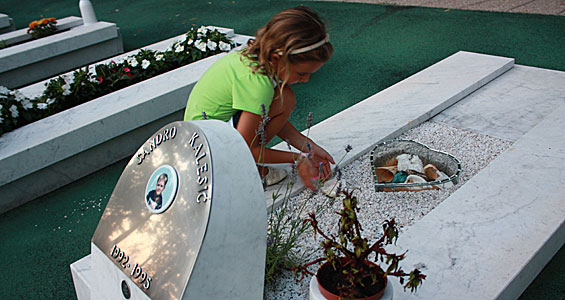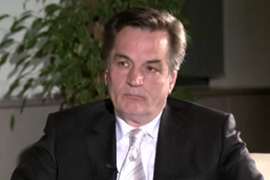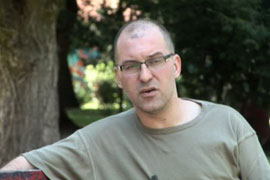Revisiting the Tuzla massacre
Mike Kirsch returns to the scene of the murder of 71 people in Bosnia in 1995.

 |
| The grave of two-year-old Sandro Kalesic, one of 71 people murdered in the massacre |
On May 25, 1995, as a journalist covering the war in Bosnia, I walked into the main hospital in the town of Tuzla in northern Bosnia.
I entered the building to the sounds of screaming and crying and total chaos. I recoiled, quickly stepping out of the way of a hospital orderly walking toward me in a shoe-deep river of blood in the lobby.
| In video |
|
|
He was pushing a broomstick with a window-washing squeegee attached, redirecting the flow of blood to the outside of the front entrance, where it smacked the pavement like several litres of water tossed from a bucket.
The blood was flowing on the tile floor from several operating rooms, and from panic-filled hospital corridors.
Doctors and nurses worked feverishly to save the lives of more than 200 civilians, who had just been ripped apart by a Bosnian Serb artillery shell that exploded in front of a crowded outdoor café in the centre of town just before 9pm that evening.
Seventy-one people died that night. Most of them were between the ages of 18 and 25.
Young child
Later, I watched a technician at the morgue weeping as he piled the heads of some of the victims in a corner after identifying the ethnicity of each one – all teenage girls – as Croats, Muslims, and Serbs.
“They were all Bosnians,” he said, tears streaming down his face. “Why were they killed?”
 |
| A technician at the morgue wept as he identified the ethnicity of each victim |
The youngest of the dead lying on the floor – the number 24 tagged around his tiny shoe – was a blonde two-year-old boy named Sandro Kalesic, his eyes still open in death, glancing upward.
His mouth was open, as if taking a breath.
He had been sitting on his father’s lap at the café when the artillery shell exploded.
There was a tiny hole in his chest where a piece of shrapnel had penetrated his heart, killing him instantly.
All of the dead would be buried side by side in the town’s idyllic youth park on a patch of ground that in the 14 years since the massacre has evolved into a well-cared-for war monument for those who died.
There are 71 marble covered graves bearing photos of each victim.
Visitors from around the country and the world pay homage to them each year when they visit Tuzla.
Daughter’s confusion
I returned to visit the graves this year, as I do almost annually, with my Tuzla-born wife, and watched a curious six-year-old girl from the US – our daughter Emma – wander among the dead.
She meandered up and down the aisles of tombstones, looking at photographs of the victims. It was her first visit of any kind to such a place.
“What is this, Daddy?” she asked.
“All of these people died together a long time ago,” I said.
She walked up to the tombstone of the youngest victim, two-year-old Sandro, and stared confusingly at his photo.
“He’s just a little boy, Daddy,” she said, looking at me for an explanation.
What could I tell my young daughter about the terrible events of the war in Bosnia?
“He died from a sickness,” I said. “All of these people died from a sickness.”
Killing fields
The Dayton peace accords, signed in 1995, stopped the flow of blood in Bosnia after the horror of thousands more who were slaughtered by the Bosnian Serb army in Srebrenica and other Bosnian Muslim towns along the river Drina.
 |
| Silajdzic, the leading Bosniak politician, wants to abolish the two-entity system |
Under Dayton, this land, these killing fields, ironically, were awarded to Bosnian Serbs as an independent political entity called Republika Srpska, which to this day remains divided in so many ways from its counterpart in the country, the Bosniak-Croat federation.
In more than a decade since Dayton was signed, few Bosnian Muslims [or Bosniaks] and other non-Serbs have managed to return to their pre-war homes in Srpska – only eight per cent of them.
The UN and human-rights groups have reported many obstacles for them in Republika Srpska.
These include discriminatory practises against minority returnees looking for jobs in public service and private employment, infringements of right to education in certain areas by maintaining segregated schools, and lack of uniform rules on pensions and health insurance.
Haris Silajdzic, the leading Bosniak politician, wants to abolish the two-entity system.
His counterpart in Republika Srpska, Milorad Dodik, threatens secession from Bosnia and Herzegovina if the Serb entity is not left free to operate as what amounts to its own undeclared independent state.
Many displaced Bosnian Muslims here say the peace agreement has turned out to be no more than the equivalent of packing and wrapping a gaping wound with gauze.
The country remains divided in so many ways. Hatred on both sides remains very close to the surface in everyday life.
Troubled future
“Many people here still have blood in their eyes,” Nedim Berberovic, a Bosnian Muslim friend and former soldier here, told me.
 |
| Berberovic is certain more war is in store for Bosnia’s future |
He is certain more war is in Bosnia’s future.
“It’s not a question of if,” he said. “It’s a only a question of when.”
As I stood at the monument for war dead at the youth park in Tuzla, I thought deeply about all the pain I had witnessed in the Bosnian war, and found myself worried about what lies ahead for this country.
I watched my daughter Emma.
She noticed flowers that had been placed on many of the graves of the 71 people who died here so many years ago.
She quietly walked over to a bed of white roses in a garden lining the monument.
She picked a flower and dropped its petals on young Sandro’s grave.
